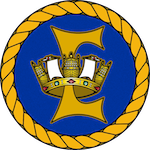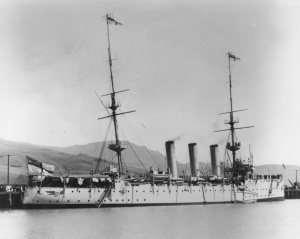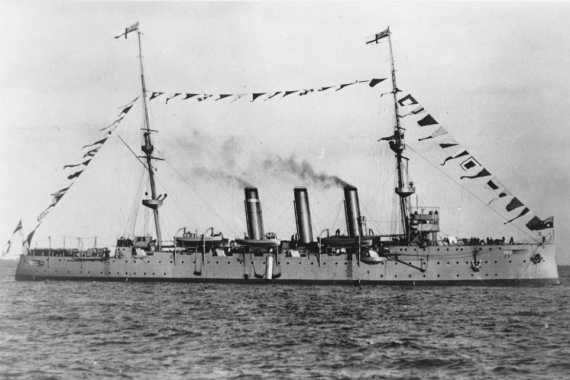HMAS Encounter (I)
| Class |
Light Cruiser |
|---|---|
| Laid Down |
28 January 1901 |
| Launched |
18 June 1902 |
| Launched by |
Lady Sturges-Jackson, wife of the admiral superintendent of Devonport Dockyard |
| Commissioned |
1 July 1912 |
| Decommissioned |
1 January 1923 |
| Dimensions & Displacement | |
| Displacement | 5880 tons |
| Length | 376 feet (114.06 metres) overall |
| Beam | 56 feet (17.06 metres) |
| Draught | 21 feet 3 inches (6.47 metres) maximum |
| Performance | |
| Speed | 21 knots |
| Complement | |
| Crew | 475 |
| Capacity | Fuel capacity 1225 tons |
| Propulsion | |
| Machinery | Two sets of four-cylinder, triple expansion steam engines; twelve Durr boilers; twin screws |
| Horsepower | 12,500 |
| Armament | |
| Guns |
|
| Torpedoes | 2 x 18-inch torpedo tubes |
| Awards | |
| Battle Honours | |

The fourth warship of the name Encounter was built at Devonport Dockyard for the Royal Navy and commissioned on 21 November 1905 under Captain CF Thursby, RN. A member of the Challenger Class, she was first rated as a second-class protected cruiser, having no side armour, but an inbuilt armoured deck. On New Year's Eve 1905 she sailed for the Antipodes to join the Royal Navy's Australian Squadron and thereafter carried out the whole of her service to the east of Suez. Encounter's next six years of service were widespread, regularly visiting Australian and New Zealand ports and the Pacific islands, but for the most part were routine.
With the post-1909 expansion of the Australian Navy underway, Encounter was lent by the British Admiralty for use as a sea going training ship pending completion of the new light cruiser HMAS Brisbane. Volunteers were called for from the existing ship's company to form a nucleus crew, remaining for a further three years in the Australian Service and receiving Australian rates of pay. Nearly a third of the men decided to stay behind. Encounter was a popular ship, and it was only fit and proper, wrote one of those returning to England, 'that the Encounter, with her fine record, should become the foster mother of the Royal Australian Navy'.
Commissioned into the RAN on 1 July 1912, Encounter became Australia's first cruiser. Over the next two years she was actively employed in training the growing Navy and showing the flag at ports all around the nation. On 4 October 1913 she joined with the remainder of the new Australian Fleet Unit (comprising the battlecruiser Australia, light cruisers, Sydney and Melbourne, and destroyers, Parramatta, Yarra and Warrego) and took part in its initial entry into Port Jackson.
In the days before the outbreak of World War I, Encounter was with the remainder of the Australian Fleet operating in Queensland waters. On receipt of the Admiralty warning order on 30 July 1914, Australia and Encounter returned to Sydney to replenish and complete repairs. War between the British Empire and Germany began on 5 August and the following day Encounter sailed from Sydney and headed north. On 12 August 1914 she intercepted and captured the steamer Zambezi, an ex-British vessel under German control, which became the RAN's first wartime prize. A month later Encounter accompanied the successful Australian operation to capture German New Guinea, escorting the transport and store ships and providing covering fire during the advance of the Military Expeditionary force from Herbertshöhe to Toma. These shots are generally regarded as the Navy's first offensive fire of the war. Encounter later took part in the search for the missing submarine AE1.
The threat posed by the German East Asiatic Cruiser Squadron under Vice Admiral Maximilian Graf von Spee remained the most pressing problem for Australian naval authorities. With the whereabouts of the German ships unknown, the Australian fleet remained on high alert and mistakes of identity were not uncommon. As one of Encounter's sailors recalled:
When the German cruisers 'Scharnhorst' and 'Gneisenau' were reported to be sailing for the Australian coast, the crew of the 'Encounter' saw heavy smoke-trails on the horizon. Captain Lewin ordered that the ship should be stripped for action. Everything inflammable was thrown overboard, including cabin fittings, bedding, and even some clothing. Stripped to the waist the crew stood to their guns. After a seemingly interminable wait it was discovered through the glasses that the 'enemy' was a rusty South Seas tramp, steaming 'flat out' for Sydney, and burning coal at a rate that made the chief engineer of the 'Encounter' sigh with envy.
Von Spee had in fact headed east across the Pacific, and in October 1914 Encounter began patrol duties in the Fiji-Samoa area in case any of his ships should return. These patrols continued into 1915 and although largely unremarkable, she did capture the small German schooner Elfrede. In July, following a refit at Sydney, Encounter sailed for Fanning Island where she landed a garrison for protection of the cable station. The Pacific cable had been cut by the German cruiser Nürnberg in September 1914 and reports had reached the Australian Naval Board that the Germans might make another attempt. One of those serving onboard Encounter at this time was Boy First Class William Evan Allan, later to become Australia's last living veteran of active service during the Great War.
Encounter returned to her Fiji patrols until the end of 1915, when the Admiralty briefly employed her in similar duties off Malaya and the East Indies. In February 1916 she was recalled to protect merchant shipping sailing around Cape Leeuwin in Western Australia. Several German commerce raiders had escaped into the Atlantic, and it seemed likely that the importance of the transport and trade routes in Australian waters might encourage the enemy to extend their attacks. With almost all the Australian Fleet employed overseas, it fell to Encounter and several cruisers of the Imperial Japanese Navy to provide the necessary convoy escort and patrols.
The first evidence of a German presence in Australian waters came on 6 July 1917 when the large cargo ship SS Cumberland struck a mine ten miles off Gabo Island. The Japanese cruiser Chikuma was first to render assistance, but Encounter arrived the next day from Port Phillip and remained to supervise salvage operations. The minefield had been laid by the raider Wolf, which later captured and sank the cargo ship SS Matunga off New Guinea. During September Encounter took part in the search for Matunga and then provided an escort for other steamships heading for Rabaul. Wolf remained undiscovered, and after 14 months at sea returned safely to Germany in February 1918. A second German raider, the sailing ship Seeadler, also reached the Pacific but sank just three small vessels before striking a reef off Mopelia Island in the Society group in August 1917. The following month Encounter was sent out to inspect the wreckage.
Encounter continued her Australian patrols until the end of the war, but peace did not bring about an immediate reduction in her employment. On 24 November 1918, the Naval Board despatched the cruiser to Fiji and Samoa on what became Australia's first overseas humanitarian assistance operation. Encounter embarked medical stores and a joint Army and Navy relief expedition, and provided valuable aid following a severe outbreak of influenza among the Indigenous populations.
Returning safely to Sydney and with no illness on board, Encounter spent less than a month at home before sailing for Darwin in the Northern Territory. Here an industrial dispute had escalated to the point where unionists directly threatened the Commonwealth-appointed Administrator, Dr Gilruth. For almost a month the cruiser provided a dominating presence in the harbour and then left for Melbourne with the Administrator and his family safely embarked.
Encounter became a permanent RAN unit in December 1919, but the active career of the 'Old Bus' was rapidly drawing to a close. On 10 January 1920 she briefly returned to her role as a sea going training ship, making several trips to Melbourne and Hobart. On 28 May she took part in the RAN's first Fleet Review in Port Phillip Bay, which honoured the visit by His Royal Highness the Prince of Wales (later King Edward VII). Between June and August Encounter visited several ports in South Australia and Western Australia before returning to Sydney and paying off on 30 September 1920.
On 1 January 1923, HMAS Penguin, the depot ship at Garden Island, Sydney, paid off after 47 years of naval service. On the same day Encounter was renamed Penguin and recommissioned for service as the depot and accommodation ship. Painted white with buff funnels, and without armament, the new Penguin spent six years at Garden Island until reductions in defence expenditure necessitated her disposal. She paid off for the final time on 15 August 1929. In 1930-31 she was stripped at Cockatoo Island Dockyard. What remained of Encounter's hull was towed to sea and sunk off Bondi Beach, Sydney on 14 September 1932. She now lies at a depth of approximately 74 metres and is still dived regularly.
Between 1965 and 1994 the name HMAS Encounter was used for the naval depot in Port Adelaide, South Australia.
Commanding Officers of HMAS Encounter (I)
| Assumed Command |
Commanding Officer
|
| July 1912 | CAPT BM Chambers, RN |
| March 1913 | CAPT A Gordon-Smith, RN |
| January 1914 | CAPT C La P Lewin, RN |
| January 1916 | CAPT CL Cumberlege, RN |
| October 1916 | CAPT JB Stevenson, RN |
| November 1918 | CAPT WHCS Thring, RAN |
| January 1919 | CAPT JF Robins, RAN |
Relics
The font in the Garden Island Chapel, Sydney, is made from timber recovered from HMAS Encounter (I).
Further reading
- 'The Log of HMS Encounter: Australian Station, 1910-1912' Petty Officer Herbert Wilson, London, The Westminster Press, circa 1913.








